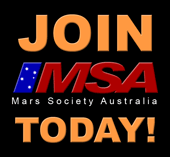Main menu
You are here
Home ›MSA 2018 AGM and President’s Report
Dear Marstralians,
MSA has had a very busy 12 months working towards expanding human presence on Mars and ensuring Australia’s role in this great challenge. There have been several highlights I would like to share with you.
The Marsobot program stepping up to balloon testing of instruments and control systems on balloon flights to the stratosphere was a major achievement. At 30 km conditions are similar to or more extreme on Mars – lower air pressures and densities, similar temperatures, high cosmic radiation and UV levels. This allows us to qualify the hardware to TRL6, an important step to developing actual flight hardware. The first flight was with the HORUS 47 launch, you can read about it here http://www.areg.org.au/archives/208044. So far flown are an Arduino microprocessor, temperature sensor, and custom spectrometer. A payload with a Rasperry Pi and multispectral camera and spectrometer is waiting for suitable weather to fly. In other news, the Marsobot has developed and tested a series of open source 400-900nm sensitive spectrometers. The results of these have been submitted to the International Journal of Remote Sensing. Work continues on further rover design, planning, building, programming, soldering, field testing on 2 X 30 cm size A4 robots and a custom Mars lander. Results were submitted to ASRC conference proceedings in 2017. Other projects include a 6 wheeled version, as well as 2 A5 size rovers for mobility testing.
David Willson was able to assemble a test segment of the Mars Oz habitat to validate the construction methods and clearances for both the upper and lower decks. The segment was on display at the NASA Ames Research Center in California for several days in August.
It’s also been great to see progress happening again with the Starchaser Marsupial project, after an extended period in storage. The vehicle is now in Adelaide being worked on by a team coordinated by the local MSA node. Long range surface mobility is the key to exploring Mars, and the Marsupial rover will allow MSA to test exploration operations and concepts and human factors. Australia is an ideal location for such work because of the vast distances and ease of access in the Outback, difficult to find elsewhere in the world.
For me personally the most exciting event in the past year was second half of the Mars 160 expedition which took me to northern Canada for two months and the Flashline Mars Arctic Research Station (FMARS) on Devon Island. This was an extraordinary experience and a great privilege, working in one of the best Mars analogue facilities and locations on Earth. The time at FMARS complete the expedition which began at the Mars Desert Research Station (MDRS) in Utah, the mission reports can be found at http://mars160.marssociety.org/. I gained a better first hand appreciation of some of the many issues that might face a crew living and working on the surface of Mars. Such was the value of the experience I would do it again with the same crew.
This year we are looking forward to major progress on two fronts, work on Marsupial and further test work with Marsobot, including more balloon flights. We hope to have one informal visit to Arkaroola. Plans are also in hand for a several visits to India to follow up the Spaceward Bound India expedition in 2015. Locations we hope to visit include the Lonar impact crater and a return to Ladakh.
On the administrative front we have been able to increase activity on both the Facebook page and the web site, the latter thanks to the efforts of Darryn Wong, Earl White, and Guy Murphy. We held our AGM in May, and the following directors were re-appointed appointed: Jonathan Clarke (president), David Willson (vice president, on leave), Guy Murphy (treasurer), Annalea Beattie (secretary, on leave), Ken Silburn, Siddharth Pandey, Marcia Tanner, and Mark Gargano. We say goodbye to Graham Mann, who has been on the MSA board for over 15 years, and served as the WA representative and as the Marsupial project manager. Graham will remain with MSA pursuing research into Mars quadrotor drones and Murdoch University. Two new directors were appointed – Rowena Christensen, a medical doctor in Melbourne an Earl White, and astronomer and IT specialist from Sydney. Our annual financial report to the Australian Charities and Not-for-profits Commission can be downloaded from https://acnc.gov.au/AIS2017?ID=28FE5452-1EBA-4524-B254-DCE85F9FBF8A&nole...
For all MSA members, remember that MSA is a group where we actually get hands on with the challenges of exploring Mars. Get involved with your local group, if there isn’t one, perhaps you can start one. Perhaps there is a project you can do together. You can also contribute to the discussion MSA Facebook page. Look into making presentations to local schools, scout groups, churches, and astronomy societies.
On to Mars!
Dr. Jonathan Clarke
MSA President

